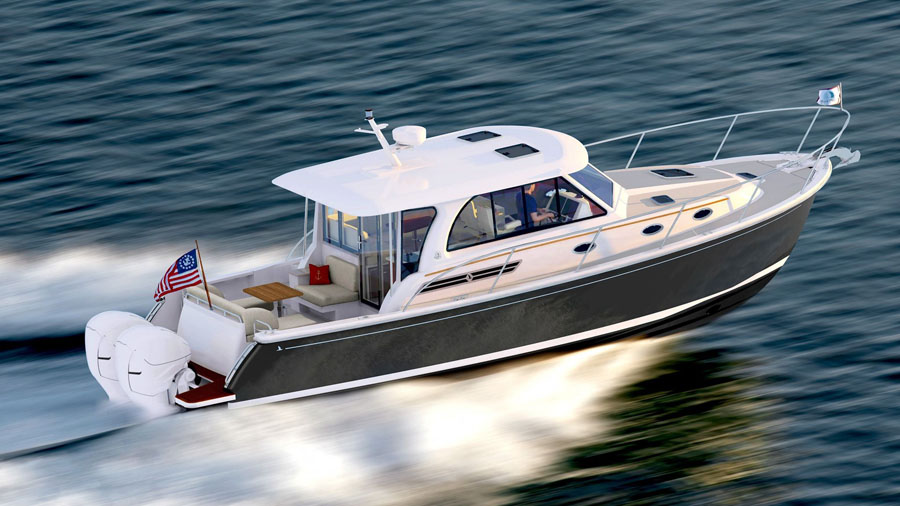
Back Cove Offers Outboard Power from a Clean-Sheet Design

From Scratch
Hardly a year has passed since Back Cove unveiled their first outboard-powered model: the 34O (where ‘O’ is for Outboard). Back Cove is not the first inboard diesel boat builder to offer an outboard-equipped model, nor are they the first Downeast-style boat builder to do so. However, Back Cove did not simply plug the holes for the shaft and rudder in their mold to churn out an outboard look-alike of a previous inboard powered model—they started with a clean sheet.
“The hull was designed from the keel up to be optimized for the outboard driveline both in terms of performance and weight distribution,” explains Kevin Burns, Back Cove’s Vice President of Design and Product Development.
Back Cove performs all design work in-house including the construction of their new Outboard model. The design team sources an outside naval architecture consultant just as an independent ‘check’ on their performance predictions and other parameters. Like other leading boat design firms and manufacturers, Burns and his design team utilize Computational Fluid Dynamics (CFD) to simulate a specific hull form’s handling and performance over a broad range of operation. This powerful software helps to hone the new hull design to near perfection before any physical tooling of prototypes or molds takes place.

“…designed from the keel up to be optimized for the outboard driveline…”
Measured Thinking
Rather than hurry to be the first to market with an outboard-equipped variant of a popular Downeast boat, Back Cove took their time. “We’ve been looking at outboard power for the last five years or so for several reasons.” Burns further explains, “The trim feature allows for more flexibility and shallower operation, while the power density is greater when it comes to HP-to-weight and HP-to-cost ratios. Also, the scale of production of outboard motors allows for increased parts availability and more common service availability over lower volume drivelines. But, most importantly, our owners asked us for a Back Cove that went faster and had a shallower draft than our inboard models.”

What is TRELIS?
TRELIS is a clever acronym for Back Cove’s patent-pending hull form and is exclusive to their outboard-powered models. The TRailing Edge LIft Surface consists of a flat surface attuned to the running angle at the aft most portion of the hull bottom. A concave waveform forward of this cutout tapers smoothly from the keel.
This exclusive hull form geometry was made possible by CFD (Computational Fluid Dynamics) software along with the drive and passion of Kevin Burns and the Back Cove design team. Rest assured, the 34O is not a one-off design but the beginning of a completely re-engineered outboard-powered model line by this renowned yacht builder.
The 34O is the fastest Back Cove model yet.
Ultimately, the new 34O from Back Cove is the most advanced model they’ve ever produced. It offers all of the brand’s familiar comforts and amenities without sacrificing any of the qualities that have made the brand such a success. There’s little doubt the popularity of this new model will continue to surge while Burns and his design team work on developing the next outboard-powered Back Cove.
Back Cove 34O
LOA: 38′ 11″
Beam: 11’ 10”
Draft: 2’ – 3′
Fuel Capacity: 250 gal.
Water Capacity: 60 gal.
Holding Tanks: 40 gal.
Displacement: 17,000 lbs.
Power Options:
Twin Yamaha F300 V6
Twin Yamaha F350 V8
Twin Suzuki DF350A V6
Back Cove Announces 39O to Debut Summer 2020
